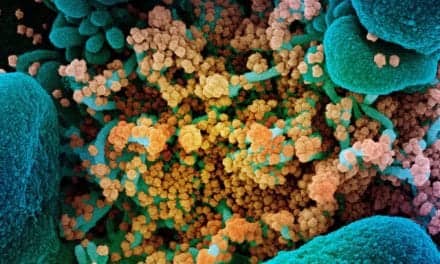For cystic fibrosis, new antibiotics and new takes on old treatment methods are needed to eradicate existing drug-resistant micro-organisms and prevent the development of new ones.
John D. Zoidis, MD
Cystic fibrosis is a disease caused by an inherited genetic defect. In fact, it is the most common autosomal-recessive disease of Caucasians and affects about 30,000 persons in the United States (60,000 persons worldwide), with an estimated 10 million asymptomatic carriers.1,2
Patients with CF suffer from chronic lung problems and digestive disorders. The lungs of people with CF become covered with a sticky mucus that is difficult to remove and promotes infection by bacteria. Many people with CF require frequent hospitalizations and continuous use of antibiotics, enzyme supplements, and other medications. The prognosis for people with CF used to be very poor, but it has improved considerably over the past three decades. In the 1960s, the mean survival age was about six years compared with 16 years in 1970, and 30 years in 1990.3 It is predicted that babies born with CF in the 1990s may live for 40 years or more.4
The Gene
For many years the cause of CF was a mystery. Today, advances in genetics and molecular biology have made the cause more clear. In 1989, the gene responsible for CF, called cystic fibrosis transmembrane conductance regulator (CFTR), was discovered on chromosome 7.5 CFTR encodes a 1480–amino acid protein with a molecular weight that varies from 140 to 170 kilodaltons.5 This protein controls the flow of chloride ions across the cell membrane. It also has roles in transporting water and small solutes, acidifying intracellular organelles, and regulating membrane sodium transport.1,2 Each CFTR gene is made up of two alleles; a single correctly encoded allele is adequate for normal protein production.
Because CF follows an autosomal-recessive inheritance pattern, a person can develop CF only if he or she has two defective CFTR alleles. Those with a single defective allele are carriers. A child must inherit a defective copy of the CF gene from each parent to have CF. Each time two carriers conceive a child, there is a 25% probability that the child will have CF; a 50% probability that the child will be a carrier; and a 25% probability that the child will be normal (a noncarrier).
The classic mutation involved in CF causes the deletion of three of the base pairs in the CFTR gene.5 This, in turn, causes a loss in the CFTR protein of one amino acid (phenylalanine at position 508 of the protein chain). Hence, this mutant protein is called dF508 CFTR; however, dF508 CFTR accounts for only 70% to 80% of all CF cases. There are more than 800 known gene mutations that can lead to CF. Differences in disease patterns observed in individuals and families probably result from the combined effects of a particular mutation and various, but still unknown, factors in CF patients and their environment. The severity of symptoms varies depending on the particular mutation. Generally, patients with milder symptoms live longer.
Pathogenesis of Pulmonary Disease
Despite the identification of CFTR, the link between the pathogenesis of pulmonary disease, inflammation, and abnormal CFTR has not been fully elucidated. CF alters the mucus secretions of the body’s epithelial cells. These cells make up the outside layer of tissue that lines every open surface of the body, inside and out, including the various tunnels and cavities in the lungs, urinary tract, liver, and reproductive tract. In patients with CF, the mucus that the epithelial cells secrete is much thicker and stickier than normal. It clogs the airways of the lungs and blocks the flow of air, making the tissue vulnerable to chronic lung infection.
Lung infection is the leading cause of morbidity and mortality in patients with CF.6 Chronic endobronchial infection accompanied by intense intraluminal infiltration of neutrophils may result in progressive bronchiectasis (see Figure 1, page 34) and obstructive pulmonary disease. Early in life, organisms that typically colonize the respiratory tract include Staphylococcus aureus and Haemophilus influenzae; later, Pseudomonas aeruginosa is a common pathogen.6,7 Recently, additional bacterial species have been identified that may chronically colonize the respiratory tract of patients with cystic fibrosis (see Table 1).
| Table 1. Bacterial species known to chronically colonize the respiratory tract of patients with CF.6,7 |
| Staphylococcus aureus Haemophilus influenzae Pseudomonas aeruginosa Nonfermentative, non-Pseudomonas gram-negative species: –Burkholderia cepacia (formerly Pseudomonas cepacia) –Ralstonia pickettii (formerly Burkholderia pickettii) –Flavobacterium spp –Chryseobacterium spp –Sphingomonas spp Stenotrophomonas maltophilia (formerly Xanthomonas maltophilia) Enterobacteriaceae: –Serratia marcescens –Enterobacter cloacae –Klebsiella pneumoniae –Escherichia coli –Citrobacter freundii Nontuberculous mycobacteria: –Mycobacterium avium complex (MAC) –Mycobacterium abscessus |
Managing Pulmonary Disease
The emergence of specialized CF centers to care for patients with cystic fibrosis has led to improved recognition and management of this potentially devastating disease. The cornerstone of CF management is aggressive antimicrobial therapy, including identification and management of drug-resistant organisms. Additional therapeutic measures useful in the CF patient include clearance of abnormal secretions and, in dire cases, lung transplantation. A therapeutic modality currently being investigated is gene therapy.
Aggressive Antimicrobial Therapy
When treating pulmonary exacerbations in patients with CF, the choice of antibiotic agents is based on the susceptibility of bacteria identified in the sputum. In children too young to cough up sputum, oropharyngeal cultures may be useful, but may not always accurately predict lower airway pathogens.4 Accepted treatment of a pulmonary exacerbation consists of using two parenteral agents from different antibiotic classes in an effort to provide synergy and delay the emergence of drug resistance.1 Most commonly, a b-lactam agent with activity against P. aeruginosa, such as ticarcillin, piperacillin, or ceftazidime, and an aminoglycoside agent are selected.3 Antibiotics with activity against S. aureus and H. influenzae are also indicated when these organisms are isolated from the respiratory tract.3 Burkholderia cepacia is intrinsically resistant to all aminoglycosides and many strains are also resistant to fluoroquinolone and b-lactam antibiotics, but meropenem has the most activity against CF strains.8
For chronic P. aeruginosa infection, an aerosolized (inhaled) antibiotic may be used instead of a parenteral formulation. However, use of aerosolized antibiotics for acute flare-ups of P. aeruginosa is controversial due to the potential for bronchospasm and the risk of developing drug-resistant bacteria.9 The first inhaled antibiotic for the treatment of patients with CF—tobramycin solution for inhalation—was approved by the US Food and Drug Administration in 1998.10,11 Another inhaled antibiotic—colistin—is also available.12 Use of inhaled antibiotics for the long-term suppression of P. aeruginosa has been shown to improve pulmonary function in patients with cystic fibrosis.13
The development of multidrug-resistant microorganisms is a growing problem in the treatment of CF. This is probably a result of the intensive selective pressure provided by using large amounts of antibiotics in these patients.14 Pseudomonal resistance has been linked to derangements in beta-lactamase activity.15 Double b-lactam therapy using aztreonam and piperacillin, ceftazidime, or imipenem may therefore be a future approach.
Development of resistance to ciprofloxacin is commonly seen,16,17 and resistance to aminoglycosides is also a problem in CF patients with chronic P. aeruginosa infection, whereas resistance to colistin is seldom seen despite selective pressure in patients receiving colistin by daily inhalation.14 Leading investigators have suggested that it is the chronic inflammation dominated by polymorphonuclear leukocytes that induces a high level of mutation in P. aeruginosa in CF lungs, and the resistant mutants are then selected by the heavy use of antibiotics.16
Clearance of Abnormal Secretions
A major focus of CF treatment is the obstructed breathing that causes frequent lung infections. Physical therapy, exercise, and medications are used to reduce mucus blockage in the airways.
Chest therapy consists of bronchial, or postural, drainage, which is done by placing the patient in a position that allows drainage of the mucus from the lungs. At the same time, the chest or back is clapped (percussed) and vibrated to dislodge the mucus and help it move out of the airways. This process is repeated over different parts of the chest and back to loosen the mucus in different areas of each lung. This procedure has to be done for children by family members but older patients can learn to do it by themselves. Mechanical aids that help chest physical therapy are available commercially. Exercise also helps to loosen the mucus, stimulate coughing to clear the mucus, and improve the patient’s overall physical condition.
Medications used to help breathing are often aerosolized and can be inhaled. These medicines include bronchodilators, mucolytics, and decongestants.
Lung Transplantation
Lung transplantation has become an accepted treatment for respiratory failure due to CF. Effective means of patient selection, surgical technique, immunosuppression, and post-transplant management permit survival as good as that of transplant patients with other diseases.18 The new lungs do not acquire the CF ion transport abnormalities but are subject to the usual post-transplant complications. Moreover, CF problems in other organ systems can persist and may be worsened by some of the immunosuppressive regimens required to prevent rejection of the transplanted lung.
Gene Therapy
A new treatment option attracting attention is gene therapy, the goal of which is to deliver a normal copy of the CFTR gene to the cells that need it. Theoretically, the DNA inserted into target cells should direct synthesis of the normal CFTR protein and reverse the primary biochemical abnormality at the root of CF.19 Introduction of the gene should replace all functions of the CFTR protein, including any that have not yet been recognized. At least 20 clinical trials evaluating gene therapy in CF are currently under way or awaiting approval.20 Choice of vector, mode of delivery to airways, translocation of genetic information, and sufficient expression level of the normalized CFTR gene are issues that currently are being addressed.
Conclusion
Despite advancements in our understanding of the pathogenesis of CF, it remains a potentially devastating disease. The hallmark of management remains antibacterial therapy in patients with chronic lung disease in an attempt to minimize or eliminate lower respiratory tract infection; however, drug resistance is a growing problem. New antibiotics and new ways of using old antibiotics are needed to eradicate existing drug-resistant microorganisms and prevent the development of new ones. It is hoped that new therapeutic modalities under development, such as gene therapy, will offer improved outcomes in patients with CF.
RT
John D. Zoidis, MD, is a contributing writer to RT Magazine.
References
1. Ramsey BW. Management of pulmonary disease in patients with cystic fibrosis. N Engl J Med. 1996;333: 179-188.
2. Moss RB. Cystic fibrosis: pathogenesis, pulmonary infection, and treatment. Clin Infect Dis. 1995;21:839-851.
3. Rajan S, Saiman L. Pulmonary infections in patients with cystic fibrosis. Sem Respir Infect. 2002;17:47-56.
4. Ramsey B, Boat T. Outcome measures for clinical trials in cystic fibrosis. Summary of a Cystic Fibrosis Foundation consensus conference. J Pediatr. 1994;124: 177-182.
5. Kerem B, Rommens JM, Buchanan JA, et al. Identification of the cystic fibrosis gene: genetic analysis. Science. 1989;245:1073-1080.
6. LiPuma JJ. Expanding microbiology of pulmonary infection in cystic fibrosis. Pediatr Infect Dis J. 2000; 19:473-474.
7. Burns JL, Emerson J, Stapp JR. Microbiology of sputum from patients at cystic fibrosis centers in the United States. Clin Infect Dis. 1998:27:158-163.
8. Burns J, Saiman L. Burkholderia cepacia infections in cystic fibrosis. Pediatr Infect Dis J. 1999;18:155-156.
9. Cunningham S, Prasad A, Collyer L, Carr S, Lynn IB, Wallis C. Bronchoconstriction following nebulized colistin in cystic fibrosis. Arch Dis Child. 2001;84:432-433.
10. Burns JL, Van Dalfsen JM, Shawar RM, et al. Effect of chronic intermittent administration of inhaled tobramycin on respiratory microbial flora in patients with cystic fibrosis. J Infect Dis. 1999;179:1190-1196.
11. Ramsey BW, Pepe MS, Quan JM, et al. Intermittent administration of inhaled tobramycin in patients with cystic fibrosis. Cystic Fibrosis Inhaled Tobramycin Study Group. N Engl J Med. 1999;340:23-30.
12. Jensen T, Pedersen SS, Garne S, Heilmann C, Høiby N, Koch C. Colistin inhalation therapy in cystic fibrosis patients with chronic Pseudomonas aeruginosa lung infection. J Antimicrob Chemother. 1987;19:831-838.
13. Moss RB. Long-term benefits of inhaled tobramycin in adolescent patients with cystic fibrosis. Chest. 2002;121:55-63.
14. Doring G, Conway SP, Heijerman HGM, et al. Antibiotic therapy against Pseudomonas aeruginosa in cystic fibrosis: a European consensus. Eur Respir J. 2000;16:749-767.
15. Giwercman B, Lambert PA, Rosdahl VT, Shand GH, Høiby N. Rapid emergence of resistance in Pseudomonas aeruginosa in cystic fibrosis patients due to in-vivo selection of stable partially derepressed b-lactamase producing strains. J Antimicrob Chemother. 1990;26:247-259.
16. Høiby N. New antimicrobials in the management of cystic fibrosis. J Antimicrob Chemother. 2002;49:235-238.
17. Jalal S, Ciofu O, Høiby N, Gotoh N, Wretlind B. Molecular mechanisms of fluoroquinolone resistance in Pseudomonas aeruginosa isolates from cystic fibrosis patients. Antimicrob Agents Chemother. 2000;44, 710-712.
18. Yankaskas JR, Aris R. Outpatient care of the cystic fibrosis patient after lung transplantation. Curr Opin Pulm Med. 2000;6:551-557.
19. Flotte TR. Gene therapy for cystic fibrosis. Curr Opin Mol Ther. 1999;1:510-516.
20. Bigger B, Coutelle C. Perspectives on gene therapy for cystic fibrosis airway disease. BioDrugs. 2001; 15:615-634.










